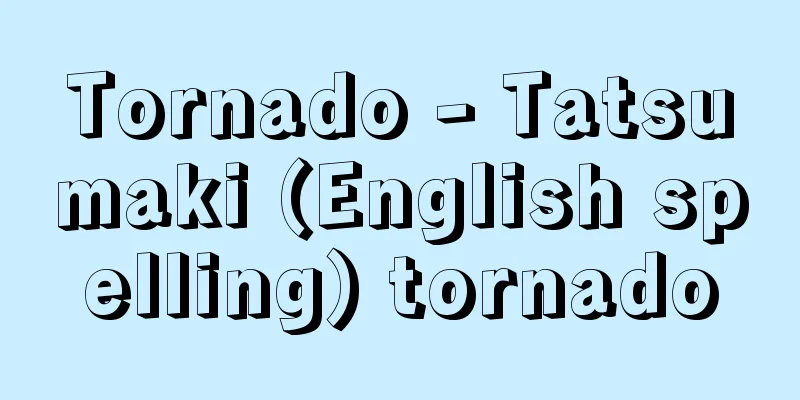Tornado - Tatsumaki (English spelling) tornado

|
A violently rotating column of air hanging from a cumulonimbus cloud. It is almost always accompanied by a funnel cloud or tuba. It is one of the most destructive localized atmospheric phenomena. The vortex has a diameter of about 100 meters, and the wind speed is estimated to be 50 to 130 meters per second. The average speed of a tornado can reach more than 30 meters per second at high speeds. There are various English names for tornadoes because they are distinguished by the fact that a tornado is a vortex accompanied by a funnel-shaped cloud that reaches the ground; a waterspout is a tornado that reaches the water surface such as the ocean; and a funnel aloft is a tornado in which the funnel-shaped cloud hangs down from the cloud base but does not reach the ground and has no effect on it; however, the academic term spout is sometimes simply used. Dust devils, sand pillars, and man-made fire whirls, smoke whirls, and steam whirls that are not associated with cumulonimbus clouds, are usually less than 50 meters in diameter and last for a few minutes are not called tornadoes. [Junkichi Nemoto and Takashi Aoki] How tornadoes differ from other atmospheric vortexesA tornado is a strong vortex with a vertical axis in the atmosphere, which differs from the cyclonic vortices seen on everyday weather charts in the following ways: (1) In a normal low pressure system, the horizontal extent is usually several tens or even hundreds of times its height, making it a very flat vortex, but a tornado is less than 100 meters in diameter and about 1,000 meters in height, making it a highly developed vertical vortex. (2) In the case of low pressure systems, the vortex rotates counterclockwise in the Northern Hemisphere. Similarly, in the case of tornadoes, counterclockwise vortexes are more common in the Northern Hemisphere, but clockwise vortexes are rare. In the Southern Hemisphere, the opposite is true. (3) The scale of the wind system in a tornado is much smaller than that in a cyclone, so the damage caused by a tornado is very localized. [Junkichi Nemoto and Takashi Aoki] The origin of tornadoesTornadoes can occur when a vortex near the ground combines with the rising air current of a cumulonimbus cloud, or when a vortex formed within the rising air current of a cumulonimbus cloud extends downward toward the ground. Most tornadoes occur in association with low pressure systems or fronts. Typhoons account for about 20% of all tornadoes. Tornadoes occur particularly frequently on the right front of a typhoon's direction of movement. In areas along the Sea of Japan, many tornadoes occur as a result of cold fronts and the outpouring of cold air caused by seasonal winds. [Junkichi Nemoto and Takashi Aoki] Phenomena associated with tornadoesIn a small area near the center of a tornado, wind speeds are extremely strong, sometimes reaching more than 100 meters per second, and in this area, the updrafts are also very strong, picking up objects on the ground and even fish from the water, causing fish rain over distant areas. Large tornadoes can emit light at night. There have already been successful photographs of them, and it is believed that some of the ancient phenomena seen as pillars of fire were caused by tornadoes that occurred at night. [Junkichi Nemoto and Takashi Aoki] Tornado wind speed and damageThe relationship between the F-scale of a tornado and the damage to wooden houses is as follows (from "Tatsumaki" by Tetsuya Fujita, published in 1973, excluding wind speed). The F-scale (Fujita scale) is an index of tornado strength devised by Tetsuya Fujita (1920-1998), a professor at the University of Chicago. F-scale: 0 If the maximum wind speed caused by a tornado is v (m/s), the following relationship exists between v and F: v = 6.30(F + 2) 3/2 m/s [Junkichi Nemoto and Takashi Aoki] distributionGlobally, about 1,000 tornadoes occur annually, with the United States having the most annual occurrences, at about 800. The central United States is the area most susceptible to tornadoes in the world, particularly in Oklahoma, Texas, Kansas, and Nebraska. Tornadoes also occur in Europe, India, Australia, New Zealand, South Africa, Paraguay, Uruguay, etc., where they are concentrated in the temperate zones and rare in the cold and tropical zones. In Europe, the number of tornadoes is extremely low compared to the United States, and they do not occur in very strong areas. In Europe, tornadoes are most prevalent in the United Kingdom, where they are found in the hilly areas around London and on the south coast. New Zealand is located in an symmetrical position to Japan across the equator, but its tornado activity is almost the same as in Japan. In some years, more than 20 tornadoes occur, but in other years, there are fewer than five. However, what makes them completely different from Japanese tornadoes is the way they spiral, with 99% of them spiraling clockwise. [Junkichi Nemoto and Takashi Aoki] Tornado ClimatologyAccording to statistics compiled by Niino Hiroshi (1953- ) and others from the Atmosphere and Ocean Research Institute, University of Tokyo, 677 tornadoes occurred in Japan in the 33 years from 1961 to 1993 (Showa 36-Heisei 5). This is 20.5 tornadoes per year. Statistics by region show that Okinawa has the most tornadoes, and there are also many on the Pacific side of Honshu. In terms of when they occur, September is the most common, with March being the least common. However, on the Sea of Japan side, peak values have been seen in January as well as September. [Junkichi Nemoto and Takashi Aoki] FolkloreThe phenomenon of a whirlwind that blows seawater up into the sky is called "tornado" because it is seen as a dragon rising to the heavens. Dragons are imaginary animals in ancient India and China, but in Japan, which adopted this popular belief, there has long been a belief in Tatsu. The Wamyō Ruijūshō states "dragon, Japanese name: Taito." The origin of the word Tatsu is not entirely clear, but it is thought to be a word that probably means the appearance of a divine spirit, as in the examples of Tassho and Kandatsu. If this is the case, then tornadoes are indeed reminiscent of the appearance of a divine spirit. Dragons were already thought of as snake-shaped in China, and the idea of dragons rising to the heavens was also possible, so Japanese tornadoes were naturally dominated by this idea. In Tachibana Nankei's (1754-1806) "Journey to the East" (1795-1798), there is an account of a man who, in a tornado that occurred near Okitsu on the Tokaido (Shizuoka prefecture), was so frightened that the people on the ship cut off their hair and burned it, and the stench drove it away. This may be an indication that they believed the tornado to be a snake. [Takatoshi Ishizuka] "Tornaments - The Wonders of Vortices" by Fujita Tetsuya (1973, Kyoritsu Shuppan)" ▽ "Stories of the Wind 1" edited by Ito Manabu (1986, Gihodo Shuppan)" ▽ "Stories of Weather" 1-2 edited by Mitsuda Yasushi (1988, Gihodo Shuppan)" ▽ "The Global Environment and Fluid Mechanics" edited by the Japanese Society of Fluid Mechanics (1992, Asakura Shoten)" ▽ "A Small Surprising Dictionary of Storms and Typhoons - The Invisible Super Power" by Shimada Moriie (1992, Kodansha)" ▽ "An Easy Meteorological Classroom" by Shimada Moriie (1994, Tokai University Press)" ▽ "The Science of Weather - Protecting Yourself from Meteorological Disasters" by Ogura Yoshimitsu (1994, Morikita Shuppan)" ▽ "Visual Learning Encyclopedia Discovery" by David Elyard, Japanese edition supervised by Harada Akira, translated by Ono Yoko Meteorology (1998, Kin no Hoshisha) ▽ Modern and contemporary history of meteorological disasters in Japan, written by Miyazawa Seiji (1999, Ikaros Publishing) ▽ Disaster and Accident Yearbook, edited by Disaster Information Center, 2000 edition (2000, Maruzen) ▽ Typhoons and Tornadoes: A comprehensive look at abnormal weather from avalanches to the El Niño phenomenon, written by Jack Challoner and supervised by Hiranuma Yoji for the Japanese edition (2000, Dohosha, Kadokawa Shoten) ▽ Thunderstorms and Mesoscale Meteorology, written by Ohno Hisao (2001, Tokyodo Publishing) ▽ Basic knowledge of wind for weather forecasting, written by Yamagishi Yonejiro (2002, Ohmsha) ▽ Meteorology to protect lives, written by Aoki Takashi (2003, Iwanami Shoten) ▽ Ishihara Yoshizumi's Ishihara Yoshizumi's fun life as a weather forecaster (Shogakukan Bunko) [References] | | | | | | | | | | | | | |The figure shows a schematic diagram of the parent cloud type that generates a tornado and its radar echo image. The blue and dotted lines in the figure show the movement of air currents, and the tornado that has been generated is shown in red. ©Shogakukan Parent cloud type that gives birth to tornadoes Source: Shogakukan Encyclopedia Nipponica About Encyclopedia Nipponica Information | Legend |
|
積乱雲から垂れ下がった激しく回転する気柱。ほとんどの場合、漏斗(ろうと)雲(英語でfunnel cloudまたはtubaという)を伴っている。局地的な大気現象の一種であるが、もっとも破壊的な現象である。この渦動(かどう)は直径100メートル程度で、風速は毎秒50メートル以上から130メートルにも達するのではないかと見積もられている。竜巻の平均移動速度は速い場合は毎秒30メートル以上に達することもある。 竜巻の英語がいろいろあるのは、漏斗状雲に伴われた渦が地上に達した場合をトルネードtornado、海上などの水面に達した場合をウォータースパウトwaterspout、雲底から漏斗状の雲は垂れ下がるが、地表まで達しないで地表にはなんの影響も与えない場合をファネル・アロフトfunnel aloftと区別しているからであるが、学術用語としては単にスパウトspoutを使用することもある。 積乱雲に伴わない、通常直径が50メートル以下、寿命は数分程度の、塵(じん)旋風dust devil, sand pillarや人為的条件が加わって発生する火事旋風、煙旋風、蒸気旋風は、竜巻とはよばれない。 [根本順吉・青木 孝] 竜巻と他の大気中の渦動との相違竜巻は大気中に垂直軸をもつ強い渦動であるが、これが日常天気図などでみられる低気圧性の渦と異なる点は次のとおりである。 (1)普通の低気圧では、通常その水平方向の広がりが、その高さの数十倍ないし数百倍あり、たいへん扁平な渦であるが、竜巻は直径が100メートル以下で、高さは1000メートル程度である。このため垂直方向に著しく発達した渦巻である。 (2)低気圧の場合、北半球では渦が反時計回りである。竜巻の場合も同様に北半球では反時計回りの渦が多いが、まれに時計回りの竜巻もある。南半球ではこの反対である。 (3)風系としての規模は低気圧に比べ竜巻のほうがはるかに小さい。したがって竜巻に伴われた被害もきわめて局地的なものである。 [根本順吉・青木 孝] 竜巻の成因竜巻は、地面付近の渦が積乱雲の上昇気流と結び付いて発生する場合と、積乱雲の上昇気流の中にできた渦が地面に向かって下に伸びて発生する場合とがある。竜巻の多くは低気圧や前線に伴って発生する。台風に伴う竜巻も全体の約20%に達する。とくに台風の進行方向右前面で竜巻の発生が多い。日本海沿岸の地域では、寒冷前線や季節風による寒気の吹き出しに伴う竜巻が多い。 [根本順吉・青木 孝] 竜巻に伴う現象竜巻の中心付近の狭い範囲は風速がきわめて大きく、毎秒100メートル以上に達していることもあるが、その部分では、上昇気流もきわめて大きく地表の地物を巻き上げたり、水面からは魚を巻き上げて、離れた場所に魚の雨を降らせたりすることがある。 大規模な竜巻は夜間に発光することがある。すでに写真撮影に成功した例もあり、古来、火柱が立ったとみられた現象の一部は、夜間の竜巻によるものと考えられる。 [根本順吉・青木 孝] 竜巻の風速と被害竜巻のF‐スケールと木造住宅の被害の関係は以下の通りである(1973年発行の藤田哲也著『たつまき』による。ただし、風速は除く)。F‐スケール(藤田スケール)は、シカゴ大学教授であった藤田哲也(1920―1998)が考案した、竜巻の強さを示す指標。 F‐スケール:0 竜巻による最大風速をv(m/s)とすると、vとFの間には次のような関係がある。 v=6.30(F+2)3/2m/s [根本順吉・青木 孝] 分布世界的にみると年間約1000個の竜巻が発生しており、地域的にもっとも多いのはアメリカ合衆国で年間約800個発生している。アメリカの中央部は世界でもっとも竜巻の発生しやすい地域である。とくにオクラホマを中心としてテキサスやカンザス、ネブラスカなどで多くみられる。 このほかで竜巻の発生がみられるのはヨーロッパ、インド、オーストラリア、ニュージーランド、南アフリカ共和国、パラグアイ、ウルグアイなどであり、緯度的には温帯に集中し寒帯、熱帯では少ない。ヨーロッパではアメリカに比較すると数はきわめて少なくなり、またあまり強い竜巻は現れない。ヨーロッパでもっとも多いのはイギリスで、ロンドン付近の丘陵地と南海岸に多い。赤道を挟んで、日本と対称の位置にあるのがニュージーランドであるが、竜巻の活動状況は日本とほとんど同じくらいである。多い年は20個以上発生するが、少ない年は5個以下という年もある。ただし、日本の竜巻とまったく異なっているのはその巻き方で、全体の99%が時計回りの渦巻である。 [根本順吉・青木 孝] 竜巻の気候誌東京大学大気海洋研究所の新野宏(にいのひろし)(1953― )らの統計によると、日本では1961~1993年(昭和36~平成5)の33年間に677個の竜巻が発生している。これは年間20.5個の発生である。地域別の統計によると、竜巻は沖縄がもっとも多く、本州の太平洋側でも多い。発生する時期をみると、9月がもっとも多く、3月が少ない。しかし日本海側では9月のほかに1月にも極大値が現れている。 [根本順吉・青木 孝] 民俗旋風が海水を空へ巻き上げる現象で、それを竜が天に昇るものとみるところから「竜巻」の名がある。竜は古代インド・中国における想像上の動物であるが、この俗信を受け入れた日本でも古くからタツという信仰はあった。『倭名類聚抄(わみょうるいじゅしょう)』に「龍、和名太都」とある。タツの語源はかならずしも明らかでないが、おそらくタッショ、カンダツなどの例のように、神霊の出現を意味する語であろうといわれている。そうとすれば竜巻こそまさに神霊の出現そのものを思わしめるものであったといえる。竜は中国においてすでに蛇形のものとする考えになっており、竜が天に昇るという思考もできていたから、日本の竜巻も自然この考えに支配された。橘南谿(たちばななんけい)(1754―1806)の『東遊記』(1795~1798)に、ある人の話として、東海道興津(おきつ)(静岡県)のあたりで竜巻がおこり、船中の人々恐れて頭髪を切って火に焼き、その臭気でこれを退けたとあるのは、竜巻の正体を蛇とみた表れであろう。 [石塚尊俊] 『藤田哲也著『たつまき――渦の驚異』(1973・共立出版)』▽『伊藤学編『風のはなし1』(1986・技報堂出版)』▽『光田寧編著『気象のはなし』1~2(1988・技報堂出版)』▽『日本流体力学会編『地球環境と流体力学』(1992・朝倉書店)』▽『島田守家著『暴風・台風びっくり小事典――目には見えないスーパー・パワー』(1992・講談社)』▽『島田守家著『やさしい気象教室』(1994・東海大学出版会)』▽『小倉義光著『お天気の科学――気象災害から身を守るために』(1994・森北出版)』▽『デイビッド・エリヤード著、原田朗日本語版監修、小野蓉子訳『ビジュアル学習図鑑ディスカバリー 気象』(1998・金の星社)』▽『宮沢清治著『近・現代 日本気象災害史』(1999・イカロス出版)』▽『災害情報センター編『災害・事故年鑑』平成12年版(2000・丸善)』▽『ジャック・シャロナー著、平沼洋司日本語版監修『台風と竜巻――なだれからエルニーニョ現象まで異常気象を一望する』(2000・同朋舎、角川書店発売)』▽『大野久雄著『雷雨とメソ気象』(2001・東京堂出版)』▽『山岸米二郎著『天気予報のための風の基礎知識』(2002・オーム社)』▽『青木孝著『いのちを守る気象学』(2003・岩波書店)』▽『石原良純著『石原良純のこんなに楽しい気象予報士』(小学館文庫)』 [参照項目] | | | | | | | | | | | | | | | |図は、トルネードを発生させる親雲の型とそのレーダー・エコーの画像を模式的に描いたものである。図中の青い線と点線は気流の動きを示し、赤色で示したのが発生したトルネードである©Shogakukan"> トルネードを生む親雲の型 出典 小学館 日本大百科全書(ニッポニカ)日本大百科全書(ニッポニカ)について 情報 | 凡例 |
>>: Illegal activity - Dappoukoi
Recommend
Cowherd boy - Ushikaiwara
〘 noun 〙 A person who drives an ox cart . They hav...
Archeometry
…Conservation science can be defined as the natur...
Oscilloscope - Oshirosukopu (English spelling) oscilloscope
A device for observing and recording the time-dep...
Edmondo De Amicis
1846‐1908 Italian author. He joined the military a...
Red maple (English spelling)
…(4) Red maple A. pycnanthum K. Koch (illustratio...
Crambinae
...15 species are native to Japan. (3) The Crambi...
Old Asian Flu - Kyuajiakaze
…This epidemic has been known since Greek times, ...
Cauchy-Hadamard's formula
… For a given power series, the upper bound ρ of ...
Active Center - Catalytic Center
A specific site on the surface of a solid catalys...
Temple and shrine land
From ancient times to the early modern period, lan...
Volto Santo (English spelling)
...The birthplace of composer G. Puccini. [Aichi ...
Water lily - Suiren (English spelling) water lily
An aquatic plant of the Nymphaeaceae family (APG ...
Wu Song (English)
He is one of the 108 leaders in the Chinese novel ...
Oral Composition
...In other words, the narrator did not recite me...
United Nations Forces
The term "United Nations forces" refers...









